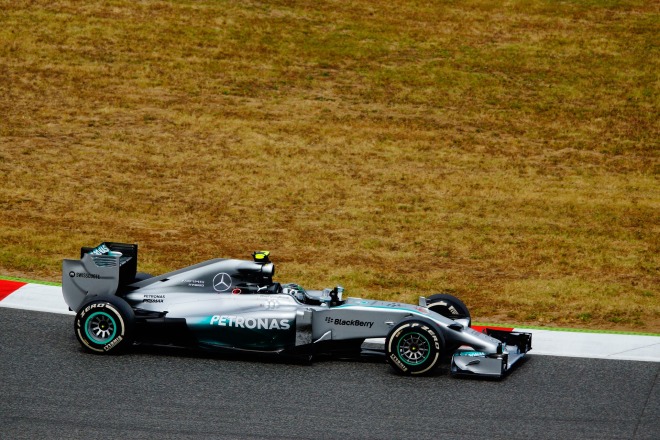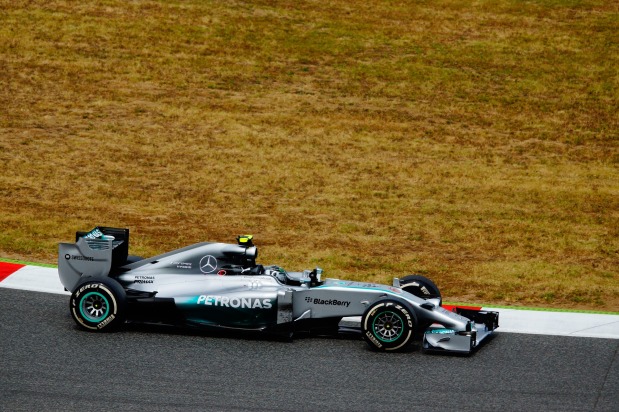
Nico Rosberg claimed his first F1 world drivers’ title in Abu Dhabi
Loyalty can be seen as a fault in many sportspeople but for Nico Rosberg – F1’s newest world champion – it is probably his best quality.
Existing in a world of driver merry go-rounds, Rosberg has had just two teams throughout his 11-year F1 career.
Beginning with Williams in 2006, he spent four seasons with the British privateer team before joining the might of Mercedes in 2010.
Despite a difficult start, the German consistently outperformed F1 legend Michael Schumacher at the team and finally, in his seventh campaign with the Brackley-based outfit, his loyalty has paid off with a world title.
Rosberg is known for sticking to his guns. His system of operation is to study his car’s setup in forensic detail, chipping away at the balance throughout a race weekend until he has extracted the maximum performance from it.
In addition, this season especially, and despite being the title favourite before today’s season-ending Abu Dhabi GP, he has insisted he is just taking each race as it comes with his sole focus on trying to claim victory.
Rosberg’s studious approach has often undermined his talent – of which he clearly has plenty.
He comes from a racing background and has now emulated his father Keke, who won the driver’s title in 1982 through a triumph of consistency over victories, of which he took none.
Nico joins Damon Hill – 1996 world champion – as the only other driver to have won the world title after his father.
Of course, after 11 seasons in the sport, Rosberg has clearly had to wait a long time for world championship glory.
His feat took 206 races to accomplish – the longest stint in history – and is beaten only by Nigel Mansell’s 12-year drought in terms of timespan.
Rosberg also took 111 races to secure his first race win, which came in the 2012 Chinese Grand Prix. He has since gone on to take 22 more, benefiting from the outstanding Mercedes car in the new hybrid era.
However, he will always be compared to team-mate Lewis Hamilton, who had won the two previous championships in a straight fight between the pair.
This sudden projection into battle has tested their once strong friendship. The duo had grown up racing each other in karting and spent a considerable amount of time together on and off the track.
Now, their relationship looks strained, often frosty.
Perhaps the low point in recent times occurred when Rosberg threw his cap at Hamilton in the aftermath of Hamilton’s 2015 title win at Austin, when Rosberg had run wide when leading, gifting his rival the win he needed to clinch his third career title.
But there can be no doubt that the unmatched pace of the Mercedes car presented each driver with a unique situation.
They both knew that they would likely enjoy a private war for the title, such has been the superiority of their Mercedes car.
And there can also be no doubt that this driver pairing has forced the other to up their game.
For Rosberg, his aim has been to beat Hamilton – widely acclaimed as a faster, more naturally talented racer.
For Hamilton, his target has been to dominate races in the same way his idol, Ayrton Senna, did.
At times, the duo have realised their goals – but neither has had a true rule over the other.
Rosberg has had periods of dominance, such as winning the first four races of this season, that created a foundation for his title win.
Whereas Hamilton had been irresistible in July, winning all four races. His latest win in Abu Dhabi was also his fourth in succession and his tenth overall.
Rosberg has notched nine victories, but it is the same quality his father exhibited which has eventually taken him to his title win – consistency.
Looking at the numbers, he has put himself into a fantastic position in each Grand Prix.
For a start, he has never qualified adrift of the top two. He has made fewer poor starts than Hamilton and he has had fewer retirements – the only one coming during the pair’s infamous crash in the Spanish Grand Prix in May.
Much has been made of Hamilton’s misfortune with power-unit failures. Realistically, his retirement when leading the Malaysian Grand Prix was his downfall – but Rosberg only finished third after a first-corner tangle with Sebastian Vettel.
Hamilton’s other gremlins occurred in China and Russia during qualifying. His seventh place to Rosberg’s victory in Shanghai was the costliest, but he recovered to take second in Sochi, again behind his team-mate.
Hamilton had also been in terrible form in Baku and Singapore, leaving Rosberg to take easy wins.
There lies the difference. Where Hamilton has dropped the ball, his team-mate has invariably punished him. The triple world champion has also suffered a number of shocking starts from pole or second.
The getaway in Japan springs to mind as another major factor in his demise, having gone from second to ninth before the first turn. He later clawed back third place.
The bottom line is that Rosberg has raised his level and maintained it across the record-breaking length of this 21-race season.
He has not been intimidated by past failings against Hamilton, notably in wheel-to-wheel combat.
He has also appeared stronger mentally than his rival, whose emotions have notoriously fluctuated throughout the duration of 2016.
Adding all these equations together we are left with a simple answer: Nico Rosberg completely deserves to be the new F1 world champion.
You can follow me on Twitter @NeilWalton89 and WordPress: neilwalton089

